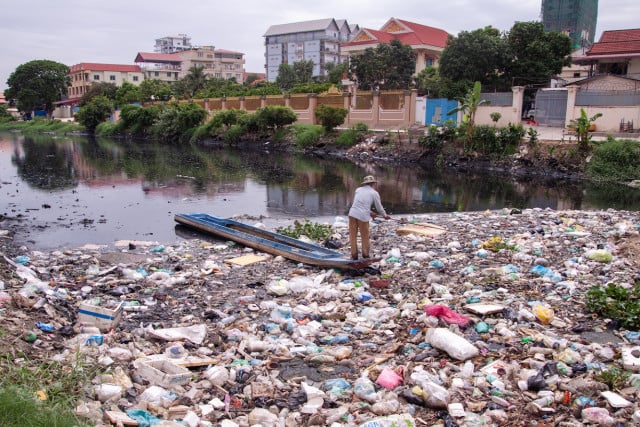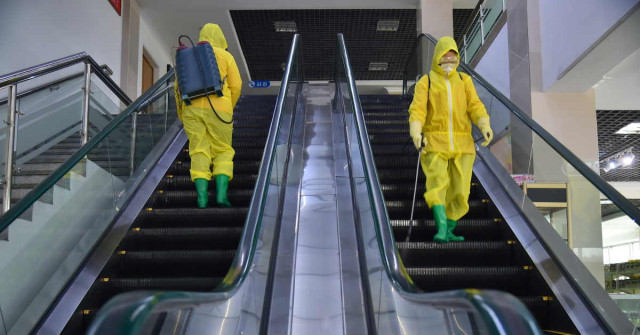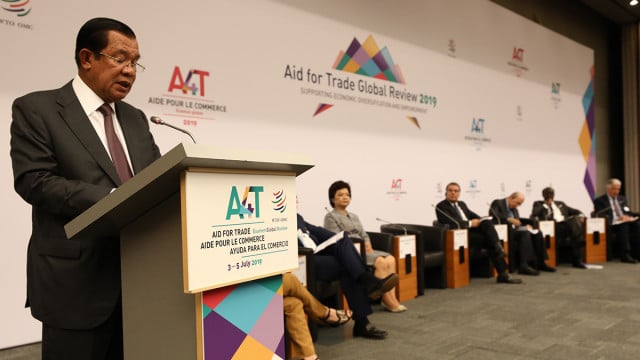Opinion: Waste Management is Great, but it’s Not Enough

- By Sarah Kolbenstetter
- November 23, 2021 11:50 AM
Making a case for Zero Waste, Phnom Penh-based environmental consultant Sarah Kolbenstetter argues that ambitious new approaches towards consumption must be taken to save Cambodia from its waste problem
“We recycle as much as possible” is a phrase that I hear way too often, and it irks me the same each time. Of course, recycling is great and it does a lot to help us save raw materials in our production processes, as well as energy. It also reduces air and water pollution from landfilling by diverting waste and reduces the emission of greenhouse gases. But is recycling really the magical solution to our waste problem?
Let’s remind readers what exactly can and cannot be recycled: In theory, glass, paper and cardboard, electronics, textiles and metals can all be recycled. Again, in theory, all types of plastics can be recycled too. But in reality, only a minuscule fraction of these materials is actually recycled. For example, since the beginning of plastic production around the 1950s and until 2015, the world has produced 6.3 billion tons of plastic waste, only 9 percent of which has been recycled and about 1 percent has been recycled more than once! But why? What prevents us from recycling more?
Experts identified four factors that prevent us from recycling more: These are infrastructure, costs, contamination and markets.
The first one, infrastructure, is relatively easy to understand: In order for recycling to actually happen, we need the appropriate recycling facilities and also collection systems. While these are fairly easy to find in the developed world, countries like Cambodia do not have the necessary infrastructure to recycle all the above-mentioned materials. That is why, in Cambodia, recyclable materials such as cardboard, paper, aluminum and tin, and HDPE and PET (two types of plastics out of the seven existing ones) are collected through the informal sector known locally as Edjai and sent, or in some cases, trafficked actually, to neighboring countries.
Many people want and have been wanting to reform this less than perfect system and introduce new recycling options in Cambodia. However, here is where the market becomes the issue: Whatever the end product of the recycling process is, someone needs to see enough value in it to buy it.
This is what often prevents recycling initiatives from being successful and sustainable in the Cambodian context, but elsewhere too. What is more, it is often forgotten that recycling plants require a constant and sufficient influx of materials, which is not always easy to achieve. Cost is also an issue—often, recycling entails higher financial costs than disposal—although environmental costs need to be further assessed, but disposal is therefore most of the time the preferred option.
Last but definitely not least, contamination is a significant obstacle for recycling. But what exactly do we mean by contamination and why does it matter? A waste stream is said to be contaminated when materials are found in the waste stream which should not be there, or when materials are not cleaned properly, making them unfit for recycling.
Let’s take the example of a plastic waste stream meant for recycling. As we said earlier, in theory all plastics can be recycled, but in practice it’s mostly PET and HDPE (plastic types 1&2) that are recycled. If other plastic types such as Styrofoam or plastic bags enter the waste stream and build up to a certain volume, then none of it will be recycled at all. Also, if some of the plastics are too dirty, the whole batch will end up in the landfill instead of being recycled.
A Pressing Issue
In conclusion, we can say that the recycling system, and especially in lower-income countries such as Cambodia, is still largely developing and that we therefore cannot rely on it to solve our waste problem.
But what exactly is this waste problem we are talking about? Well, let’s first start by taking a look at what is happening around us: Everywhere you go in Cambodia—and this is true of other countries too—you see stacks of waste lying around in nature, slowly making its way into our oceans, helped by winds and rainfalls.
This causes water and air pollution and severely impacts marine life, and any kind of life it encounters on its way to the ocean. And ultimately, this pollution finds its way back into our plates through the foods we eat. Once in the ocean, waste, and especially plastic, breaks down into millions of tiny pieces known as microplastics, which makes it literally impossible to recover.
Experts expect that by 2050, there will actually be more plastic in the water than fish. To add to the challenge, global annual waste generation is projected to increase by 70 percent between 2018 and 2050 unless major changes take place.
And even if the waste that we produce was actually “managed,” the way we “manage” it is far from ideal. In Cambodia, waste that is not dumped is either collected and brought to the landfill, or, in more rural areas where no waste collection and management systems actually exist, the waste is simply incinerated.
Yet, and apart from being a terrible eyesore, landfills have a highly negative environmental impact. The three main problems with landfill are toxins, leachate and greenhouse gases. Many materials that end up as waste, such as electronics for example, contain toxic substances. Over time, these toxins leach into our soil and groundwater, and become environmental hazards for years. Leachate is the liquid formed when waste breaks down in the landfill and water filters through that waste. This liquid is highly toxic and can pollute land, ground water and water ways.
Finally, greenhouse gas production is perhaps the biggest environmental threat posed by landfills. Greenhouse gases form in landfills when organic material such as food scraps is put in landfills. Due to the lack of oxygen in waste piles, organic materials produce greenhouse gases as they break down.
Landfill gas actually comprises 30-44 percent carbon dioxide and 35-55 percent methane, a greenhouse gas estimated to be 25 times more potent than carbon dioxide!
Methane is also a flammable gas that can become dangerous if allowed to build up in concentration—a problem that has seen landfills catch fire in Cambodia, presenting a danger to waste management workers and adding to air pollution.
On the other hand, waste incineration also comes with its share of environmental nuisances, because it creates and releases harmful chemicals and pollutants into the air, water ways and food supplies. Some of these chemicals lead to lung and heart diseases, others to neurological diseases and cancers and a wide variety of other health problems, which are only beginning to be discovered and understood.
All in all, there is no doubt that neither of these waste management practices are sustainable in the long run and that waste poses an existential threat to life on earth.
So, what could the solution be?
Two Words: Zero Waste.
Zero waste is defined by the Zero Waste International Alliance (ZWIA) as “The conservation of all resources by means of responsible production, consumption, reuse, and recovery of products, packaging, and materials without burning and with no discharges to land, water, or air that threaten the environment or human health.”
Zero Waste refers not only to keeping waste out of landfill through better waste management and recycling, but also to encourage our economy to be less wasteful in production and consumption.
Because, let’s face it, our current culture of consumption is unsustainable. Extracting raw materials requires large amounts of energy and causes pollution and processing these materials require even more energy and cause even more pollution. Worst of all, once they’re used, the goods are simply dumped in a landfill or destroyed in an incinerator.
Zero Waste goals are certainly ambitious. So how exactly can we achieve them?
Well, let us first mention that Zero Waste is not an end goal but rather a set of guiding principles that strive towards eliminating waste at all stages of the production chain.
Zero Waste entails three underlying obligations that target different sections of society: Producer responsibility, political responsibility and community responsibility.
Producers must take responsibility for product design and manufacturing, for example by designing objects made out of recycled materials or which can be more easily repaired or remanufactured. The community needs to take responsibility to consume less and better and also to ensure that disposal allows as many materials to be reused. Finally, and in between both, political responsibility must bridge the gap between community and producer, promoting environmental and human health through appropriate policies in line with Zero Waste principles.
And yes, you read this correctly: Consuming better and less is the key to solving our waste problems. And yes, I know some of you are cringing when reading this, but unfortunately there is no way around it.
Did you know that for each ton of waste we as consumers produce, about 71 tons of waste have been created upstream in the production process? This is called the “wasteberg” effect.
As frightening as it is, it also shows that changing our consumption habits could actually have a strong positive effect and has the potential for saving tons of resources and preventing tons of waste from being generated. So, what are we waiting for?
Sarah Kolbenstetter is an environmental consultant specialized in waste reduction and improved waste management based in Phnom Penh and the founder of an environmental consulting company, Little Green Spark. She holds a bachelor’s degree in politics and international relations from the University of Sussex (UK) and a master’s degree in international development from the University of Amsterdam (Netherlands). After having worked in the development sector for almost a decade in Europe, Latin America and Africa, she decided to change her career path to help businesses and organizations operating in Cambodia to reduce and better manage the waste they produce.















